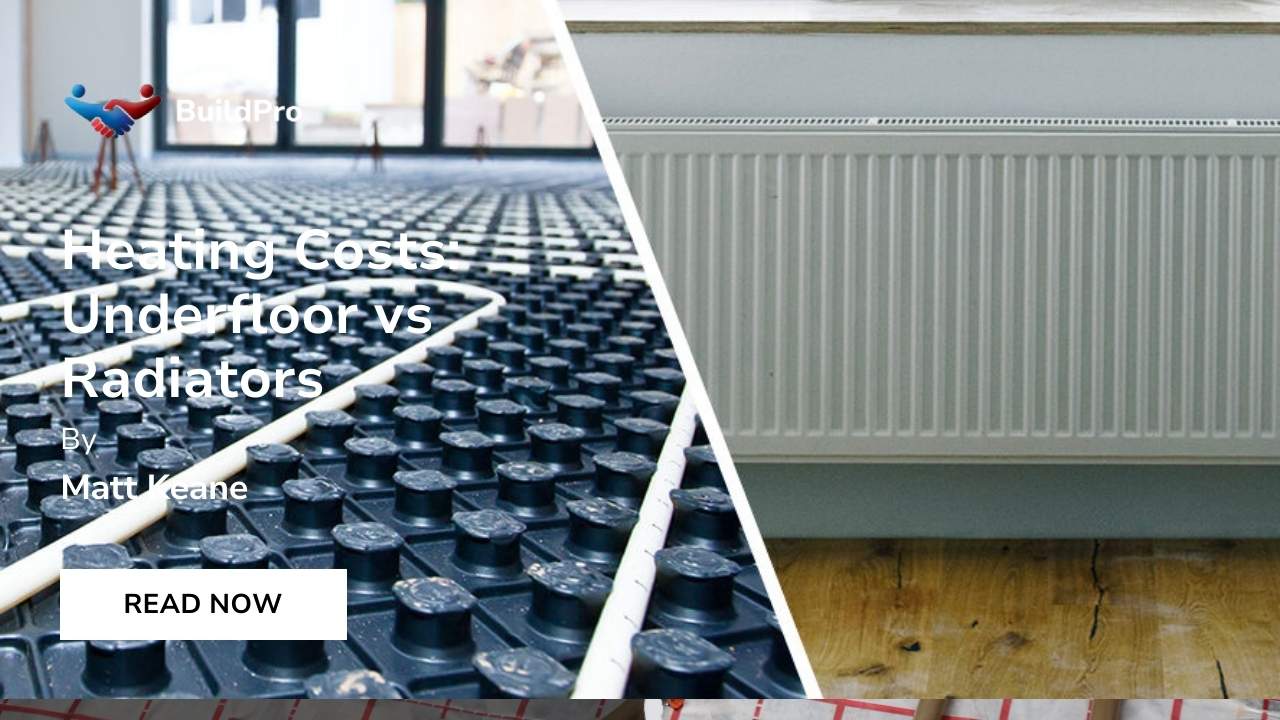Choosing a heating system for your home is a critical decision. It influences your comfort, the quality of your living environment, and your energy bills. In the contemporary world of heating, there are two main rivals: underfloor heating and radiators. You might ask, "What is cheaper, underfloor heating or radiators?" To answer this question and more, let's dive into an in-depth analysis of these two systems.
What is Underfloor Heating?
Underfloor heating, also referred to as radiant heating, involves the installation of pipes or electrical wires beneath the floor of a house. These systems distribute heat across the floor surface, effectively turning your floor into a large heat emitter.
Underfloor heating systems come in two primary forms: wet or hydronic systems that use water heated to around 50 degrees Celsius, and electric systems, which utilise electrical heating wires. Both types have unique benefits and drawbacks.
Hydronic systems are typically more expensive to install but more cost-effective in the long run, while electric systems are cheaper to install but have higher running costs.
Underfloor heating is growing increasingly popular due to its superior thermal comfort, increased energy efficiency, and space-saving benefits. However, it also involves more extensive construction work and can take longer to heat up than radiators.
What are Radiators?
Radiators, or central heating systems, work by heating water in a boiler, which is then circulated through a network of pipes to radiators installed in various rooms. The radiators emit heat into the room, warming the space.
Radiators have been the traditional go-to for home heating in many countries, including Ireland. They are typically easy to install, particularly in new builds or during significant renovations. Plus, radiators offer quicker heat response times than underfloor heating.
However, radiators may be less efficient at distributing heat evenly throughout a room, often leading to cold spots. They also take up wall space, which may limit your decorating options.
How Does Underfloor Heating Work?
Underfloor heating works on the principle of heat radiation and natural convection. When turned on, the system heats the floor surface, which then radiates heat upwards, warming the entire room.
For hydronic underfloor heating systems, a series of pipes connected to a boiler or heat pump circulates warm water underneath the floor. In contrast, electric systems use a network of wires connected to your electricity supply.
The floor acts as a large, low-temperature radiator, distributing heat evenly across the room from the ground up.
The heat generated by underfloor heating systems is more evenly distributed than that of radiators, resulting in fewer cold spots and a more consistent room temperature. However, it’s important to note that these systems take longer to heat up due to their larger heating surface area.
How Do Radiators Work?
Radiators work by heating water in a boiler to a high temperature. This heated water is then pumped through pipes to radiators positioned throughout the house. As the hot water enters the radiators, they begin to emit heat, warming the surrounding air.
Unlike underfloor heating, which operates on radiant heat, radiators function primarily through convection. Hot air from the radiator rises, and cooler air is drawn in to be heated, creating a cycle that helps distribute warmth throughout the room.
Despite being less efficient at distributing heat evenly compared to underfloor heating, radiators heat up and cool down more rapidly, allowing for quicker response times to changes in temperature settings.
Comparison of Underfloor Heating and Radiators
Now that we have understood the basic functioning of underfloor heating and radiators let’s delve deeper and compare these popular home heating methods.
Efficiency of Underfloor Heating vs Radiators
Underfloor heating is generally considered more efficient than radiators. Because it uses radiant heat rather than convection, it doesn't have to work as hard to heat a room. Heat naturally rises, so starting from the floor ensures even heat distribution across the room, minimising heat loss and energy waste.
On the other hand, radiators need to be heated to a higher temperature (typically around 65-75 degrees Celsius) compared to underfloor heating systems (usually around 29-35 degrees Celsius) to achieve the same level of room comfort, which may require more energy.
However, the efficiency of a heating system can also depend on other factors, such as the insulation properties of your house, the outdoor temperature, and the heating demands of your household.
Cost of Underfloor Heating vs Radiators
In terms of installation cost, radiators are usually cheaper than underfloor heating. A central heating system with radiators can be easier and quicker to install, particularly in an existing house, while underfloor heating can require significant construction work.
However, the operational cost is where underfloor heating has the edge. Due to its greater energy efficiency, underfloor heating tends to have lower running costs in the long term, particularly hydronic systems. This can result in significant savings on energy bills over time.
Installation of Underfloor Heating vs Radiators
The installation process for underfloor heating can be more complex and time-consuming compared to radiators, particularly for wet systems. It involves laying pipes or wires beneath the floor, which can require lifting floorboards or digging up concrete floors and may be disruptive in an existing home.
In contrast, radiators are relatively straightforward to install, often involving simply connecting the radiators to the existing heating system. However, they take up wall space, which can be considered if space is at a premium.
Maintenance of Underfloor Heating vs Radiators
Once installed, underfloor heating systems require very little maintenance. Because they are installed beneath the floor, they are protected from damage, and fewer moving parts could fail.
Radiators, on the other hand, may require more regular maintenance. They can become less efficient over time due to dust accumulation and air trapped in the system. They also have more exposed parts, making them more susceptible to damage.
Environmental Impact of Underfloor Heating vs Radiators
As we strive towards greener living, the environmental impact of our heating systems is a vital consideration. Generally, underfloor heating, especially hydronic systems, are seen as more environmentally friendly. They use less energy to achieve comfortable room temperatures and can be easily paired with renewable energy sources such as heat pumps or solar thermal systems.
In contrast, radiators, especially those working with conventional boilers, can have a larger carbon footprint due to their higher operating temperatures and lower efficiency. However, combining them with modern condensing boilers or renewable energy sources can mitigate their environmental impact.
How to Choose the Best Heating System for Your Home?
When deciding between underfloor heating and radiators, consider the following factors:
- Budget: Calculate both the installation and running costs to understand each system's total cost comprehensively.
- Installation: Consider the level of disruption during installation and the available space in your home. Underfloor heating can be easier to install during a new build or significant renovation.
- Efficiency: Evaluate how efficiently each system can heat your home. If your home is well-insulated, underfloor heating might be more efficient.
- Maintenance: Assess the level of maintenance each system requires. Underfloor heating typically needs less maintenance than radiators.
- Environmental impact: If sustainability is important to you, consider the environmental impact of each heating system. Underfloor heating, particularly when paired with renewable energy sources, is usually more eco-friendly.
Remember, your choice of heating system can significantly impact your comfort, energy bills, and environmental footprint.
Choose the Right Heating System for Your Home with BuildPro!
At BuildPro, we understand that every home and homeowner is unique, and so too are their heating requirements. Our expert team can help you navigate the maze of heating options and guide you towards the best solution for your needs. Whether that's underfloor heating or radiators, we can provide professional, reliable advice and top-notch installation services.
Are you ready to make your home warmer and more energy-efficient? Get in touch with the BuildPro team today!
















